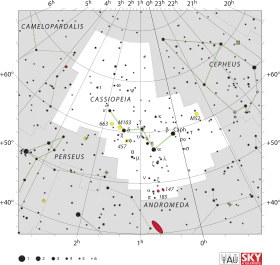HD 7924
HD 7924 est une étoile située dans la constellation de Cassiopée et distante de ∼55,5 a.l. (∼17 pc) de la Terre[1]. Il s'agit d'une naine orange de type spectral K0,5V[3]. C'est une étoile un peu moins massive, un peu moins grande, et moins lumineuse que le Soleil. Elle est l'hôte d'un système planétaire comprenant trois planètes connues.
HD 7924
| Ascension droite | 01h 21m 59,11373s[1] |
|---|---|
| Déclinaison | +76° 42′ 37,0382″[1] |
| Constellation | Cassiopée |
| Magnitude apparente | 7,167[2] |
Localisation dans la constellation : Cassiopée  | |
| Type spectral | K0,5V[3] |
|---|---|
| Indice B-V | +0,826 ± 0,006[4] |
| Vitesse radiale | −22,624 km/s[5] |
|---|---|
| Mouvement propre |
μα = −34,767 mas/a[1] μδ = −32,724 mas/a[1] |
| Parallaxe | 58,812 5 ± 0,016 8 mas[1] |
| Distance | 17,003 0 ± 0,004 9 pc (∼55,5 a.l.)[6] |
| Magnitude absolue | +6,04[4] |
| Masse | 0,81 ± 0,01 M☉[7] |
|---|---|
| Rayon | 0,74 ± 0,01 R☉[7] |
| Gravité de surface (log g) | 4,6 ± 0,01[7] |
| Luminosité | 0,364 ± 0,001 L☉[7] |
| Température | 5 216 ± 13 K[7] |
| Métallicité | −0,15 ± 0,03 [Fe/H][7] |
| Rotation | 0,9 km/s[8] |
| Âge | 3,0 ± 1,8 × 109 a[7] |
Autres désignations
HD 7924, HIP 6379, BD+75°58, GJ 56.5, SAO 4386, TYC 4494-1346-1[6]
Système planétaire
Trois exoplanètes, nommées HD 7924 b, HD 7924 c et HD 7924 d, sont en orbite autour HD 7924. La planète b a été découverte en 2009 et les planètes c et d en 2015[9]. Toutes trois sont des Super-Terres[10].
| Planète | Masse | Demi-grand axe (ua) | Période orbitale (jours) | Excentricité | Inclinaison | Rayon |
|---|---|---|---|---|---|---|
| b | 0,027 3 (± 0,001 7) MJ | 0,056 64 (± 0,000 69) | 5,397 92 (± 0,000 25) | 0,058 (+0,04 −0,056) |
1,05 RJ | |
| c | 0,024 7 (± 0,002 3) MJ | 0,113 4 (± 0,001 4) | 15,299 (± 0,003 3) | 0,098 (+0,069 −0,096) |
||
| d | 0,020 3 (± 0,002 5) MJ | 0,155 1 (± 0,001 9) | 24,451 (± 0,017) | 0,21 (± 0,13) |
Notes et références
- (en) A. Vallenari et al. (Gaia collaboration), « Gaia Data Release 3 : Summary of the content and survey properties », Astronomy & Astrophysics, vol. 674, , article no A1 (DOI 10.1051/0004-6361/202243940, Bibcode 2023A&A...674A...1G, arXiv 2208.00211). Notice Gaia DR3 pour cette source sur VizieR.
- (en) E. Høg et al., « The Tycho-2 catalogue of the 2.5 million brightest stars », Astronomy & Astrophysics, vol. 355, , L27-L30 (DOI 10.1888/0333750888/2862, Bibcode 2000A&A...355L..27H)
- (en) Kaspar von Braun et al., « Stellar diameters and temperatures - V. 11 newly characterized exoplanet host stars », Monthly Notices of the Royal Astronomical Society, vol. 438, no 3, , p. 2413–2425 (DOI 10.1093/mnras/stt2360, Bibcode 2014MNRAS.438.2413V, arXiv 1312.1792)
- (en) E. Anderson et Ch. Francis, « XHIP: An extended Hipparcos compilation », Astronomy Letters, vol. 38, no 5, , p. 331 (DOI 10.1134/S1063773712050015, Bibcode 2012AstL...38..331A, arXiv 1108.4971)
- (en) C. Soubiran et al., « Gaia Data Release 2. The catalogue of radial velocity standard stars », Astronomy & Astrophysics, vol. 616, , p. 8, article no A7 (DOI 10.1051/0004-6361/201832795, Bibcode 2018A&A...616A...7S, arXiv 1804.09370)
- (en) HD 7924 -- Star sur la base de données Simbad du Centre de données astronomiques de Strasbourg.
- (en) A. Bonfanti et al., « Revising the ages of planet-hosting stars », Astronomy & Astrophysics, vol. 575, , article no A18 (DOI 10.1051/0004-6361/201424951, Bibcode 2015A&A...575A..18B, arXiv 1411.4302, lire en ligne)
- (en) R. Earle Luck, « Abundances in the Local Region II: F, G, and K Dwarfs and Subgiants », The Astronomical Journal, vol. 153, no 1, , p. 19, article no 21 (DOI 10.3847/1538-3881/153/1/21, Bibcode 2017AJ....153...21L, arXiv 1611.02897)
- « The Extrasolar Planet Encyclopaedia — Catalog Listing », sur exoplanet.eu
- https://arxiv.org/pdf/1504.06629.pdf
Cet article est issu de wikipedia. Text licence: CC BY-SA 4.0, Des conditions supplémentaires peuvent s’appliquer aux fichiers multimédias.